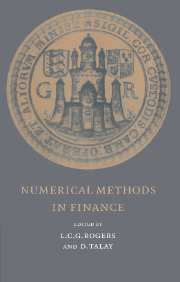Book contents
- Frontmatter
- Contents
- Contributors
- Introduction
- Convergence of Numerical Schemes for Degenerate Parabolic Equations Arising in Finance Theory
- Continuous-Time Monte Carlo Methods and Variance Reduction
- Recent Advances in Numerical Methods for Pricing Derivative Securities
- American Options: A Comparison of Numerical Methods
- Fast, Accurate and Inelegant Valuation of American Options
- Valuation of American Option in a Jump-diffusion Models
- Some Nonlinear Methods for Studying Far-from-the-money Contingent Claims
- Monte Carlo Methods for Stochastic Volatility Models
- Dynamic Optimization for a Mixed Portfolio with Transaction Costs
- Imperfect Markets and Backward Stochastic Differential Equations
- Reflected Backward SDEs and American Options
- Numerical Methods for Backward Stochastic Differential Equations
- Viscosity Solutions and Numerical Schemes for Investment/Consumption Models with Transaction Costs
- Does Volatility Jump or Just Diffuse? A Statistical Approach
- Martingale-Based Hedge Error Control
- The Use of Second-Order Stochastic Dominance To Bound European Call Prices: Theory and Results
The Use of Second-Order Stochastic Dominance To Bound European Call Prices: Theory and Results
Published online by Cambridge University Press: 05 June 2012
- Frontmatter
- Contents
- Contributors
- Introduction
- Convergence of Numerical Schemes for Degenerate Parabolic Equations Arising in Finance Theory
- Continuous-Time Monte Carlo Methods and Variance Reduction
- Recent Advances in Numerical Methods for Pricing Derivative Securities
- American Options: A Comparison of Numerical Methods
- Fast, Accurate and Inelegant Valuation of American Options
- Valuation of American Option in a Jump-diffusion Models
- Some Nonlinear Methods for Studying Far-from-the-money Contingent Claims
- Monte Carlo Methods for Stochastic Volatility Models
- Dynamic Optimization for a Mixed Portfolio with Transaction Costs
- Imperfect Markets and Backward Stochastic Differential Equations
- Reflected Backward SDEs and American Options
- Numerical Methods for Backward Stochastic Differential Equations
- Viscosity Solutions and Numerical Schemes for Investment/Consumption Models with Transaction Costs
- Does Volatility Jump or Just Diffuse? A Statistical Approach
- Martingale-Based Hedge Error Control
- The Use of Second-Order Stochastic Dominance To Bound European Call Prices: Theory and Results
Summary
Introduction
Since the seminal article of Black and Scholes (1973) on option pricing, a vast amount of literature has been written concerning options. Most of these articles consider perfect and complete markets, where options can be replicated by self-financing strategies involving continual revisions in a portfolio containing the underlying security. The price is then shown to be the ‘riskneutral’ expected cash-flows discounted at the risk-free rate: see for instance the seminal articles of Harrison & Kreps (1979), Harrison & Pliska (1981, 1983), Karatzas (1988) and El Karoui & Rochet (1989).
However, very broadly speaking, in any financial model, the equilibrium price of any asset is found to aggregate the risk-aversions of the individuals and their demands for this asset taking into account its correlation with the state variables of the economy (see for instance the general equilibrium model of Cox, Ingersoll & Ross (1985)) or with a ‘well-defined’ variable (Breeden 1989). But expected utility is, in general, a function of all the moments of the distribution: rules and pricing involving only two moments or duplication are valid only for a limited class of utility functions, or for specific distributions. For several years, finance research has got rid of utility functions in option pricing through the inspired idea of duplication. If the option is simply, at each instant, a portfolio composed of two others assets, then of course its price is the simple sum of the prices of the two assets (the underlying and the risk-free assets), these two prices being determined elsewhere.
- Type
- Chapter
- Information
- Numerical Methods in Finance , pp. 305 - 326Publisher: Cambridge University PressPrint publication year: 1997



